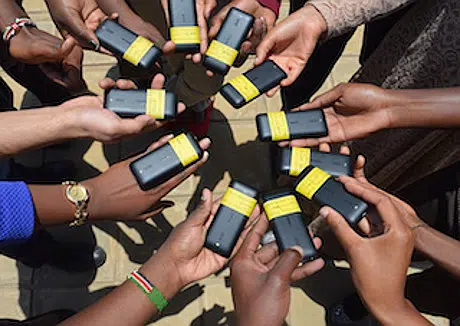
A project enabling mobile money transfers to take place at the point of sale in areas of less-developed countries with poor or no mobile network coverage has been unveiled, by removing the reliance on SMS messaging, and, instead, allowing two people to conduct a payment by copying short authentication codes between their phones.
DigiTally — funded by a grant from the Bill and Melinda Gates Foundation — works with an overlay SIM that acts as a second SIM card in the phone, project lead and University of Cambridge professor Ross Anderson told NFC World.
The overlay SIM is tamper-resistant and designed to stick on top of the regular SIM card found in both smartphones and feature phones today.
Standalone electronic purse
“It has its own cryptokey material and value counter, so it can act as a standalone electronic purse,” Anderson explained.
“Now, when you have two phones that are offline where there’s no network at all and there’s no means of communicating between them electronically, you have to pass the information back and forth using people as the interface.
“So, what you have to do is have a challenge made by the payee — so the shopkeeper — and a response to authorise the transaction made by the customer. What happens in the offline operation is that you, as the shopkeeper, would say to me, ‘OK, you want to pay me $4, here is a challenge code’.
“You put $4 into your phone and my name as the payee, and the phone then produces an eight-digit challenge and you show this challenge to me. I type it into my phone or you speak it out and I type it into my phone.
“I also select you as the payee and select $4 as the amount and my phone can then check, using cryptography, using a message authentication code mechanism, that we agree on the payee, the payer and the amount. While we’re in agreement, my phone can generate an authorisation code — another eight-digit number — which I show to you and you type into your phone.
Faster transaction
“As soon as you type that in and it’s been verified as correct, your value counter in your SIM card increases by $4 and mine is, of course, decreased as soon as I generate the authorisation code. So, we’ve managed to exchange money and this takes about 30 seconds, which is actually slightly faster than using the existing system because of network delays.”
“We did a pilot at the beginning of September in Strathmore University in Nairobi,” Anderson continued. “We piloted it in the bookshop, the coffee shop and the cafeteria to see how well it would perform under stress.
“The thing that we were most worried about was its ability to deal with high-volume retail outlets — cafes, supermarkets and so on. In the cafeteria, you have hundreds of kids suddenly descending on the place at noon, grabbing plates of rice and stew or whatever and heading for five checkout lanes.
“We were running DigiTally in these checkout lanes and the checkout staff actually preferred it to normal M-Pesa because it’s faster.”
Play money
“The obvious way to deploy this is to integrate it into an existing mobile payment service,” Anderson added. “We don’t know if that’s the path that will be taken — we’ve obviously been speaking to a number of service operators. There are various other ways in which this technology can be used to support development.
“What we need to do now is to find a second-stage partner and do a much wider field trial, a pre-production trial, or pilot with live money and live customers. What we were doing in Nairobi was in some sense play money because, although it was real value, it wasn’t connected to any payment system.
“We handed out the cards at the beginning of the experiment and, at the end of the experiment, we gathered them up and we found out how much money was on each of them. Now, to do a larger-scale pilot, we have to do some integration with an existing mobile money system so that people can feed it with real money and use it in the field.”
Next: Visit the NFCW Expo to find new suppliers and solutions